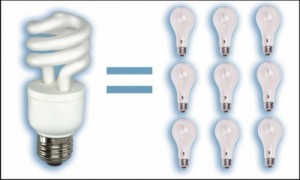 I was telling a friend the other day about how I was replacing all the incandescent bulbs in my house with Compact Florescent Light Bulbs (CFLs.) In return, she dampened my enthusiasm considerably by notifying me that what I was doing was bad for the environment. Why? Because CFLs contain mercury. And as everyone knows, mercury is hazardous to health. So I decided to do a little research and it turns out, despite their mercury content, CFLs are still very much the way to go. Here’s what I found:
I was telling a friend the other day about how I was replacing all the incandescent bulbs in my house with Compact Florescent Light Bulbs (CFLs.) In return, she dampened my enthusiasm considerably by notifying me that what I was doing was bad for the environment. Why? Because CFLs contain mercury. And as everyone knows, mercury is hazardous to health. So I decided to do a little research and it turns out, despite their mercury content, CFLs are still very much the way to go. Here’s what I found:
Each CFL contains about 5 milligrams of mercury, about enough to cover the head of a pin. Incandescent bulbs contain no mercury (but do contain lead.) So lets say that at the end of its lifetime, a CFL ends up in a landfill (forget that there are recycling programs in place) and all of its mercury ends up in the environment. That is indeed unfortunate, but wait. I learned that 50% of the power produced in this country comes from coal powered plants which release mercury into the environment (along with other greenhouse gasses.) How much mercury? The comparison is this: over the 7500 hour lifetime of a CFL the energy requirements of incandescent bulb (of comparable brightness) will cause the release of 13.16 milligrams of mercury into the environment. The energy requirements to light the CFL will cause 3.51 milligrams of mercury release. So the CFL has the potential to cause the release of 4.65 milligrams less mercury over its lifetime than does the incandescent bulb. And once again, that’s assuming the CFL ends up in a landfill and its mercury content not recycled.
Other reasons to use CFLs. According to Energy Star, an EPA program, if each home replaced just one incandescent bulb with a CFL, the electricity saved could light 3,000,000 homes. And prevent greenhouse emissions equivalent to 800,000 vehicles. Over its lifetime a CFL will save enough money to pay for the gas to drive a Prius coast to coast. So this spring make it a point to replace your dead incandescent bulbs with CFL’s. And even if a CFL breaks in your house and that tiny bit of mercury spills, clean-up requires minimal precaution (the real danger is cutting yourself with the glass.)
So I thank my friend for bringing up the topic of mercury in CFLs so that we can all be better informed. For more information on the safe handling and disposal of CFLs, go to Popular Mechanics or Treehugger.
Image via Cleaner Greentechnica









